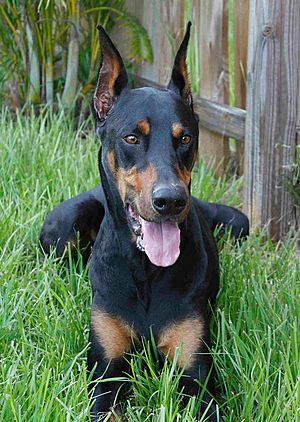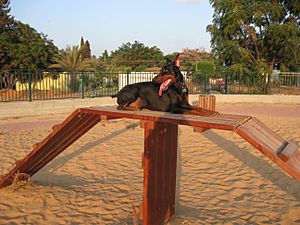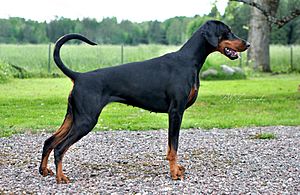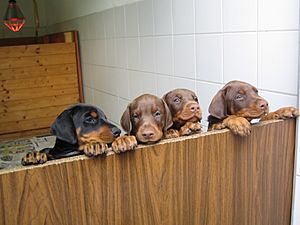Dobermann facts for kids

Dobermann with traditional coloring
|
|||||||||||||||||||||||||||||
| Other names | Doberman | ||||||||||||||||||||||||||||
|---|---|---|---|---|---|---|---|---|---|---|---|---|---|---|---|---|---|---|---|---|---|---|---|---|---|---|---|---|---|
| Common nicknames | Dobie Dobermann Dobynm |
||||||||||||||||||||||||||||
| Origin | Germany | ||||||||||||||||||||||||||||
|
|||||||||||||||||||||||||||||
|
|||||||||||||||||||||||||||||
| Domestic dog (Canis lupus familiaris) | |||||||||||||||||||||||||||||
The Doberman or Doberman Pinscher is a medium to large dog breed. It first came from Germany around 1890. This dog was named after Friedrich Louis Dobermann. He was a tax collector who wanted a loyal dog. He needed a dog for companionship and protection. Dobermans are known for being very smart, loyal, and brave dogs. They often work with police forces. They also help in search and rescue missions. Some Dobermans are guard dogs or guide dogs for people who are blind.
Contents
What Dobermans Look Like
Doberman Pinschers are medium-large dogs. They have a strong, square body and a short coat. They are built to be athletic and fast. A Doberman should look proud and watchful. They are also known for being determined and obedient.
The first Dobermans were bred to be guard dogs. Male Dobermans usually look very strong and muscular. Female Dobermans are thinner but still look strong.
Size and Body Shape
The size of Dobermans can vary a bit. This depends on the specific breed club standards. For example, male Dobermans are usually between 68 to 72 cm (27 to 28 in) tall. Females are usually between 63 to 68 cm (25 to 27 in) tall.
Dobermans have a square body shape. This means their body length is about the same as their height. Their head, neck, and legs are also in good proportion to their body.
There are no strict rules for a Doberman's weight. However, they should be big enough to be strong, fast, and have good energy. Males usually weigh between 40 to 45 kg (88 to 99 lb). Females typically weigh between 32 to 35 kg (71 to 77 lb).
Doberman Colors
Dobermans can come in different colors. These colors are based on two main genes. The most common color is black, often called black and rust. This means they are black with reddish-brown markings.
Other colors include red (or brown), blue, and fawn (a light tan color). Blue Dobermans are like a diluted black. Fawn Dobermans are like a diluted red. There are also very rare "white" Dobermans. These dogs have a cream color with white markings and light blue eyes. This is a type of albinism.
Sometimes, dogs with diluted colors like blue or fawn can have skin problems. This condition is called Color Dilution Alopecia. It is not life-threatening.
Tail and Ears
A Doberman Pinscher's natural tail is quite long. However, many Dobermans have short tails. This is because their tails are often surgically shortened soon after birth. This procedure is called docking. It has been done for hundreds of years.
The idea behind docking was to keep the tail from getting in the way of the dog's work. This practice is common in some countries like the United States. But it is illegal in many parts of Europe and Australia.
Dobermans often have their ears cropped. This means a part of their ear is surgically removed. Then the ears are taped to stand upright. This is done to match the traditional look of the breed. It is also thought to help with hearing and guard duties. Like tail docking, ear cropping is illegal in some countries.
How Smart Are Dobermans?

Dobermans are known for being very intelligent dogs. They are good at learning, solving problems, and communicating. Experts often rank them among the smartest dog breeds.
For example, a psychologist named Stanley Coren ranked the Doberman as the 5th most intelligent dog. This was based on how well they learned obedience commands. Other studies have also shown Dobermans to be very trainable. Along with breeds like the Border Collie and German Shepherd, Dobermans are considered one of the easiest dogs to train.
Doberman Temperament
Doberman Pinschers are sometimes thought of as fierce or aggressive. This is because they were first bred to be protection dogs. They needed to be large, fearless, and willing to defend their owners. But they also had to be obedient.
Over the years, breeders have worked to make Dobermans calmer. Today's Dobermans are known for being more even-tempered. They are extremely loyal, very smart, and easy to train. Their size, short coat, and intelligence make them good house dogs. Dobermans are usually energetic, watchful, brave, and obedient.
They can easily learn to protect their owners. This makes them excellent guard dogs for their families. They are generally friendly with people. They can also get along with other dogs. However, Dobermans are more likely to show aggressive behavior toward strangers or other dogs than some other breeds. But they are very unlikely to be aggressive toward their owners.
Some people believe Dobermans in North America are calmer than those in Europe. This is because of different breeding choices. So, some Doberman lines are very gentle and friendly. Others are bred to be more like the original protection dogs.
History of the Doberman
Doberman Pinschers were first bred around 1890. This happened in a town called Apolda in Germany. The breed was created by Karl Friedrich Louis Dobermann. He was a local tax collector. His job was dangerous because he traveled through areas with bandits.
Dobermann also ran the local dog pound. This gave him access to many different dog breeds. He wanted to create a dog that would protect him. He aimed for a dog with strength, speed, endurance, loyalty, intelligence, and bravery. After Dobermann died, others continued to develop the breed.
No one knows the exact mix of breeds Dobermann used. But many experts think the Doberman Pinscher came from breeds like the Beauceron, German Pinscher, Rottweiler, and Weimaraner. It is also known that Greyhound and Manchester Terrier were used. Many believe that old German Shepherd dogs were a big part of the Doberman's background.
After Dobermann's death in 1894, the Germans named the breed Dobermann-pinscher to honor him. Later, the word 'pinscher' was dropped. This word means "terrier" in German, and it no longer fit the breed.
During World War II, the United States Marine Corps chose the Doberman Pinscher as their official War Dog. However, they did use other breeds too.
In the United States, the Doberman Pinscher is a very popular dog breed. It was ranked as the 12th most popular dog breed in 2012 and 2013 by the American Kennel Club.
|
See also
 In Spanish: Dóberman para niños
In Spanish: Dóberman para niños








